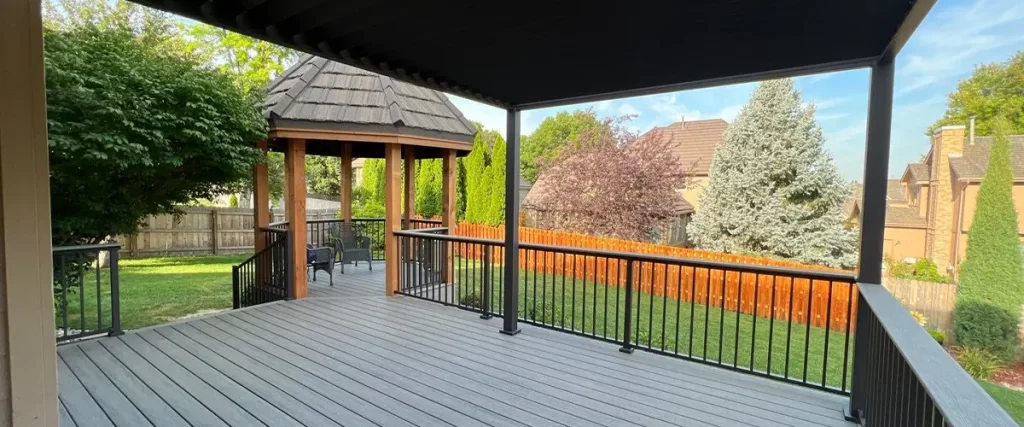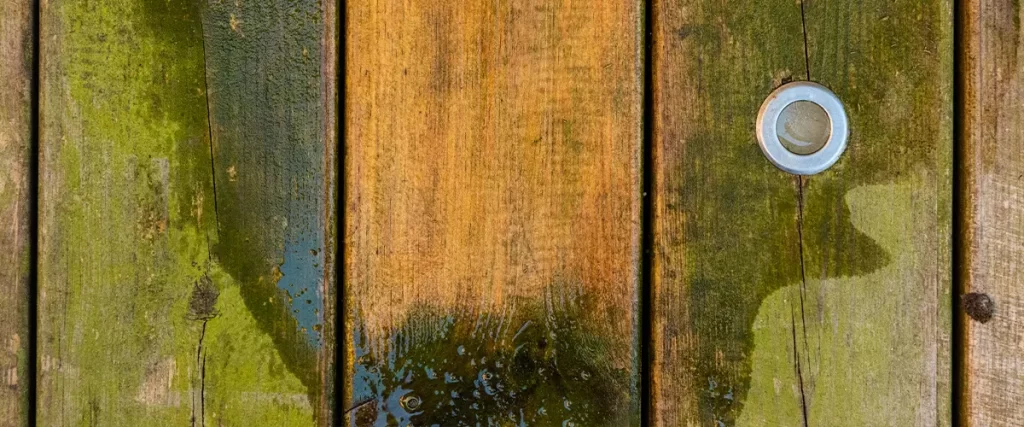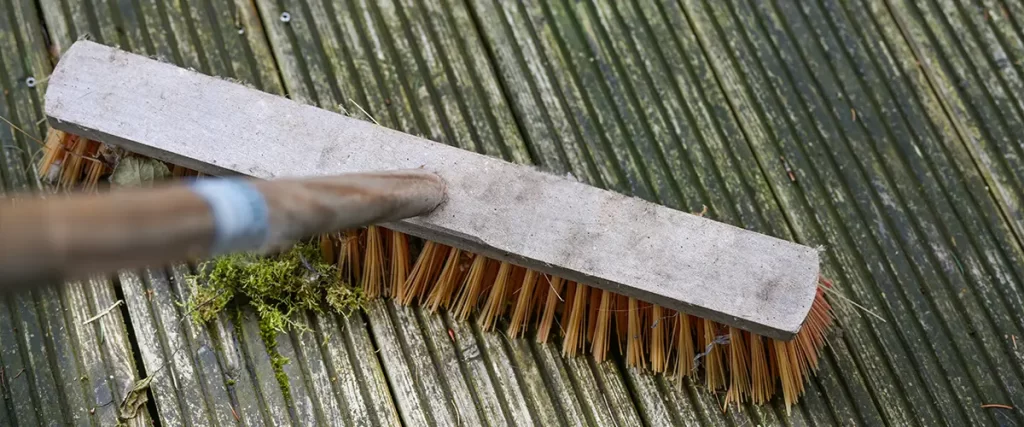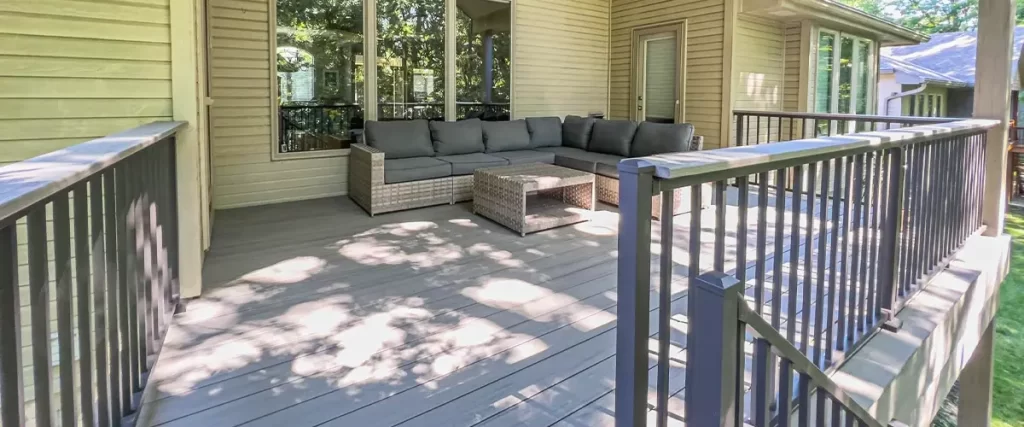If you’ve got a deck that doesn’t get much sun, you’re probably familiar with that stubborn green film that keeps creeping in. It looks gross, feels slimy underfoot, and can even make your deck downright dangerous. Yep, we’re talking about algae, that green menace that thrives in damp, shaded spots.
The good news? You’re not stuck with it forever. You can get rid of algae and keep it gone with the right approach. In this guide, we’ll walk you through everything you need to know about dealing with algae growth on shady decks. Whether you’re dealing with a slippery mess already or just trying to prevent it from happening, you’re in the right place.
Let’s break it all down step-by-step so you can reclaim your deck and enjoy your outdoor space again.

Why Algae Loves Your Shady Deck
Before we jump into solutions, it helps to understand the problem. Algae isn’t just a cosmetic issue; it’s a living organism that loves moisture, warmth, and shade. If your deck is tucked under tree cover, near a water source, or just gets very little direct sunlight, it creates a perfect environment for algae to grow.
Some contributing factors include:
- Poor drainage around or under the deck
- Accumulated debris like leaves or dirt that retain moisture
- High humidity or areas with frequent rain
- Lack of airflow, especially under or between deck boards
If you’re in a region with long, damp seasons or humid summers, algae growth can become a recurring issue unless you address the root causes.
Signs You’re Dealing With Algae (Not Mold or Mildew)
A lot of homeowners confuse algae with other organic growths like mold or mildew. Here’s how to tell the difference:
- Algae is usually green and slimy.
- Mildew is powdery, often white or gray.
- Mold is darker—black or greenish-black—and often has a fuzzy or patchy appearance.
Why does it matter? Because each requires a slightly different cleaning and prevention approach. This article focuses specifically on algae, the most common culprit on shaded decks.

Step-by-Step: How to Remove Algae From Your Deck
Okay, let’s get into the nitty-gritty. Here’s how to safely and effectively remove algae from your deck.
1. Clear Off Debris First
Start by removing leaves, twigs, and dirt from the deck surface. Use a broom or leaf blower. Algae can grow under piles of organic matter, so this step helps expose the affected areas.
2. Choose a Cleaning Solution
You’ve got options here depending on what kind of deck material you have (wood, composite, etc.) and how eco-friendly you want to be.
Some effective cleaners include:
- A mix of water and oxygen bleach (sodium percarbonate) – gentle but effective.
- White vinegar and water – a natural solution that works well in early stages of algae.
- Deck-safe commercial algae removers – always follow the label and avoid anything with harsh acids on wood decks.
Avoid chlorine bleach if you have a wood deck. It can degrade the wood fibers and damage the surrounding vegetation.
3. Scrub the Surface
Once your cleaner is applied, let it sit for 10-15 minutes (follow product instructions if you’re using a commercial solution). Then grab a stiff-bristle brush and start scrubbing. Don’t use a wire brush on composite decking—it can scratch the surface.
4. Rinse Thoroughly
Use a garden hose or a pressure washer on a low setting to rinse everything off. Be careful with pressure washers on wood decks—too much pressure can gouge the surface and make it more vulnerable to future algae growth.

How to Prevent Algae from Coming Back
Cleaning your deck is only half the battle. If you don’t change the conditions that allowed algae to grow in the first place, it’s only a matter of time before it comes back.
Here’s how to keep your deck algae-free for the long haul:
Improve Drainage and Drying Time
- Slope your deck slightly so water runs off instead of pooling.
- Check and clean gutters to prevent water from dripping onto the deck below.
- Consider adding a gravel or stone drainage layer underneath elevated decks to reduce ground-level moisture.
Trim Nearby Trees or Bushes
Open up space for airflow and sunlight. Even a little more light can make a big difference in slowing algae growth.
Use Algae-Resistant Sealants
There are deck sealers and stains that contain mildewcides or algae inhibitors. Look for ones labeled “mold- and mildew-resistant.” These not only help repel moisture but also prevent organic growth.
Keep It Clean Year-Round
A seasonal maintenance routine can make all the difference. That includes:
- Sweeping weekly
- Rinsing after big storms
- Doing a deep clean every spring and fall
Safe Cleaning Tips for Different Deck Materials
Different decks require different care. Here’s a quick breakdown to help you clean without causing damage:
For Wood Decks:
- Use soft bristles and gentle solutions like oxygen bleach or diluted vinegar.
- Avoid power washing too close to the surface.
- Reseal every 1-3 years depending on your climate.
For Composite Decks:
- Most manufacturers recommend against using harsh cleaners.
- Use warm, soapy water or manufacturer-approved cleaners.
- Don’t use metal brushes—stick with plastic bristles.
For Vinyl or PVC Decks:
- Generally low maintenance.
- Use a mild household cleaner and rinse well.
- Avoid anything abrasive that might scratch the surface.
Trusted Algae-Killing Solution Manufacturers to Know
When you’re ready to tackle algae on your shady deck, the product you choose can make or break your results. Not all cleaners are created equal—some are eco-friendly, others are heavy-duty, and a few are deck-specific. Below are some of the most trusted algae-killing solution manufacturers that homeowners and pros alike turn to.
Wet & Forget
Wet & Forget is a household name in outdoor cleaning, especially for mold, mildew, and algae.
- How it works: No scrubbing or rinsing needed—just spray it on and let the rain do the work over time.
- Deck-friendly: Safe on wood, composite, vinyl, and painted surfaces.
- Eco-aware: Non-acidic, non-caustic, and bleach-free.
- Best for: Homeowners who want a low-effort, long-lasting algae solution.
30 SECONDS Outdoor Cleaner
Known for fast results, this product works on algae, mold, and mildew with a quick spray-and-rinse formula.
- How it works: Apply it with a garden sprayer, let it sit for 30 seconds to a few minutes, then rinse off.
- Safe on: Decks, patios, outdoor furniture, and fencing.
- Bleach-based: It does contain a safe concentration of bleach, so use caution around plants and soft woods.
Simple Green
Simple Green is widely known for its environmentally responsible cleaning products, including options specifically designed for decks and siding.
- How it works: Non-toxic formula that breaks down algae and organic grime.
- Safe on: Wood, composite, vinyl, and even outdoor fabrics.
- Popular product: Simple Green Oxy Solve Total Outdoor Cleaner is a favorite among DIYers.
Spray & Forget
This is another no-rinse cleaner designed for long-term prevention as well as immediate treatment.
- How it works: Spray and leave it—rainwater will activate and remove the algae over time.
- Deck-safe: Works on wood, composite, brick, concrete, and other surfaces.
- Long-lasting: Prevents regrowth for months.
Krud Kutter
A strong but safe option, Krud Kutter’s Exterior Siding Cleaner is often used on algae-stained decks and siding.
- How it works: Breaks down organic buildup and grime with biodegradable surfactants.
- Safe for decks: Works on wood and composite, but test on small areas first.
- Good balance: Effective yet less harsh than bleach-based solutions.
Frequently Asked Questions
What is the green stuff growing on my deck?
If it’s slimy and in a shaded area, it’s most likely algae. It thrives in moist environments with little sunlight.
Is algae on my deck dangerous?
Yes. Algae makes surfaces slick and increases the risk of slips and falls—especially for kids, pets, and older adults.
Can I prevent algae without using chemicals?
You can do a lot with basic upkeep: improve airflow, keep the deck clean, and increase sun exposure. Vinegar and baking soda are effective natural alternatives for light growth.
How often should I clean my deck to prevent algae?
At least twice a year—ideally in the spring and fall. But monthly rinsing and sweeping can prevent buildup between deep cleans.
Should I pressure wash my deck to remove algae?
Yes, but with caution. Use a low-pressure setting, especially on wood, to avoid damaging the surface.

Final Thoughts: Take Control of Your Deck Again
Algae doesn’t have to win. With a little elbow grease and a consistent maintenance routine, you can keep your shady deck clean, safe, and ready to enjoy all year round.
And if you’re ever unsure about the best way to protect your deck material—or want professional guidance tailored to your situation, we’re here to help.
Contact us at (402) 369-5724 to talk through your deck building options and keep your outdoor space looking great without the stress. No hard sells—just real advice from people who care about making your home the best it can be.
